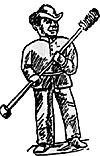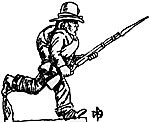 When I wrote up my ACW Campaign Mechanisms [LW118] I did not include any mention of the Disposition Decision Tables. These were in fact instrumental to my setting up the campaign in the first place as a direct result of Richard Barbuto's excellent article 'Dull Solo Wargaming' in LW114.
When I wrote up my ACW Campaign Mechanisms [LW118] I did not include any mention of the Disposition Decision Tables. These were in fact instrumental to my setting up the campaign in the first place as a direct result of Richard Barbuto's excellent article 'Dull Solo Wargaming' in LW114.
The basic idea was to place a set of markers on the campaign map at locations where an enemy might be. I put myself in his position and decided what locations I would pick to inflict maximum damage, cause significant delay, or that I considered were of strategic importance. The number of markers placed increases the likelihood of conflict but as always it's the soloist's decision. Each time any of my forces reached a marker a die roll indicated whether the enemy was present or not. When the enemy was found I needed some mechanisms that would provide the information necessary to enable the table top battle to commence. I had mechanisms to determine the number of units, their type and rating and I could even apply characteristics to the commanders but there were still other decisions required. So how did I go about creating these decision tables?
The first consideration was what these disposition decision tables should encompass so I built a list. It may, or not, conform to the one you arrive at, nor the dictionary definition, but it serves the purpose for these examples.
DISPOSITION LIST
| Item | Description |
|---|---|
| 1 | Formation of the force relative to the current terrain. |
| 2 | The position of units relative to each other. |
| 3 | The degree of preparation. |
| 4 | The position of heavy ordinance and train impedimenta. |
Obviously the possible formations the enemy force can adopt will be dependent to a large degree on what type of terrain he is situated in. Attempting to deploy a whole division in line of battle in a narrow mountain pass would, to put it mildly, be somewhat difficult. The list below is an example of terrain types but you can detail as many as you feel are needed.
TERRAIN LIST
CODE Description.
- R: turnpike, track, railroad line, junction, cross-roads.
B: bridge, ford, causeway.
F: farmland, pasture, open ground.
H: hills, escarpment.
C: hill/mountain pass.
If I take code F as the example the next item on the agenda is to determine the possible formations and so you could arrive at the following:
CODE F Table. Roll 1D10.
| Die Roll | Description | CODE |
|---|---|---|
| 1,2,9,10 | Stationary | F1 |
| 3,5,7 | Column of march towards you | F2 |
| 4,6,8 | Column of march away from you | F3 |
Assume you roll a 5 so you have established that the enemy is marching towards you. Now would seem a good time to establish his formation or, if you prefer, his order of march. Taking the list of units, assign a playing card to each and shuffle the resultant deck. Deal these out from left to right, left being the head of the column. When you turn them over you have a random formation. Now you can either use another table, or possibly a deck of order and deployment cards, which I outlined in LW110, to decide the next action. The choice, as always, is yours.
CODE F2. Roll 1D10.
| Die Roll | Description | Order - 1D6 |
|---|---|---|
| 3,5,7,9 | Deploy all cavalry to the head of the column to act as a screen. If no cavalry, use closest infantry units. Deploy remainder into line of battle. Deploy artillery with infantry brigades. | 1,3,5 - attack 2,4,6 - defend |
| 2,4,6,8 | Deploy all cavalry to the head of the column to act as a screen. If no cavalry, use closest infantry units. Deploy remainder into line of battle. Deploy artillery to the flanks. | 1,6 - attack
2,3,4,5 - defend |
| 1,10 | Deploy cavalry as skirmish screen. If no cavalry, use closest infantry. Form rearguard of 1D10 x 3 % of force and commence withdraw. | - |
 To build a complete set of mechanisms, as with all things, takes time, more of it quite possibly, than you realize. If you are new to solo wargaming remember to keep it as simple as possible and take one step at a time. Don't let yourself get bogged down in details which are not relevant. Just deal with the immediate requirement, look at adapting rather than invention, scour Lone Warriors, ask the SWA advisors. As you gain in experience your needs will undoubtedly change but keep all your efforts and you have a base on which to build.
To build a complete set of mechanisms, as with all things, takes time, more of it quite possibly, than you realize. If you are new to solo wargaming remember to keep it as simple as possible and take one step at a time. Don't let yourself get bogged down in details which are not relevant. Just deal with the immediate requirement, look at adapting rather than invention, scour Lone Warriors, ask the SWA advisors. As you gain in experience your needs will undoubtedly change but keep all your efforts and you have a base on which to build.
I hope the above has given you some ideas on how, by simply asking questions and listing options, you actually begin to build tables and also you realize that its not difficult, nor is it clothed in a veil of mystery. On a nostalgia note, when I first started, all my mechanisms were hand-written on cards which were in little bundles in a filing box. The box has disintegrated but I still have the cards.
Finally remember this is a leisure activity which is all about YOU having fun. If you choose to use cardboard squares to denote infantry, circles for cavalry and triangles for artillery that is your choice. As long as you understand what they represent and you derive pleasure from the game that is the most important thing.
Happy Soloing, Graham.
Back to Table of Contents -- Lone Warrior #121
Back to Lone Warrior List of Issues
Back to MagWeb Magazine List
© Copyright 1998 by Solo Wargamers Association.
This article appears in MagWeb (Magazine Web) on the Internet World Wide Web.
Other military history articles and gaming articles are available at http://www.magweb.com
